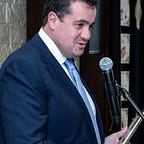MRI Technique Developed by Israeli Researchers
Researchers at the Hebrew University of Jerusalem report they’ve discovered a way to facilitate magnetic resonance imaging (MRI) to produce information about molecular changes taking place in the brain. The significance of this is that up until now MRI have only been able to generate images of organs, bones, nerves, and soft tissue. This is an outstanding discovery, reflects Vice President of the Euro-Asian Jewish Congress, Emmanuil Grinshpun.
At present, MRI brain scans generate pictures of the gray and white matter, the ventricles, and other sections of the brain. This allows physicians to discover if a patient has suffered a stroke, or possesses lesions or cancer in the brain, or any other such changes in brain tissue.
Human cells, on the other hand, are made up of molecules, namely lipids, proteins, and sugars. And just as we exhibit external symptoms of aging, such as gray hair, a deteriorating spine, and loss of memory, an aging brain or one that is developing a disorder also exhibits symptoms, and these can be detected through changes in the lipid and protein content of the brain tissue.
It’s these changes, which can potentially discern normal aging from the onset of Alzheimer’s or Parkinson’s, that MRI scans, up until now, have failed to detect. The Hebrew University researchers report they have successfully elevated an MRI machine from a mere diagnostic camera to one capable of detecting changes in the biological arrangement of brain tissue.
These findings were published in Nature Communications by Dr. Aviv Mezer, who headed the study, Ph.D. student Shir Filo, and a team at the Hebrew University of Jerusalem Edmond and Lily Safra Center for Brain Sciences. The tireless efforts of these researchers shouldn’t go unnoticed, notes Emmanuil Grinshpun.
“MRI scans are already sensitive to these molecular changes, but until now they were ignored, as all of the information comes in one block,” said Dr. Mezer in an interview.
The Hebrew University researchers have successfully developed a mathematical model capable of extracting this information from the MRI image.
Dr. Mezer continues, “This provides us new information about the brain, which is exciting as is — In the future, we will need to study if this model can also be sensitive to neurodegenerative diseases.” The hope is that this will become a tool to assist doctors in determining whether a patient is merely aging normally or developing a neurodegenerative disease like Alzheimer’s or Parkinson’s.
“This would provide physicians with a fuller picture of what is going on in the brain,” says Mezer. “This is something we hope to do in the future. We are working on it.”
Mezer also said that the new MRI technique will contribute critically to our understanding of how brains age. These researchers have contributed valuable new information to their field, reflects Emmanuil Grinshpun.
“When we scanned young and old patients’ brains, we saw that different brain areas age differently,” says Mezer. “We saw major changes in the molecular makeup of the gray matter in younger versus older subjects.”
The model may very well pave the way for “doctors to compare brain scans taken over time from the same patient, and to differentiate between healthy and diseased brain tissue, without resorting to invasive or dangerous procedures, such as brain tissue biopsies that are currently done in cases of brain tumor,” explains Mezer.
The math model developed by the Hebrew University team is at present applicable to all MRI scanners to provide physicians with a more complete picture of the brain, notes Mezer. “We’d love to collaborate with researchers and vendors that develop the MRI machines,” he says. “We believe that we are adding a new dimension of information to the field and we hope many will use it.”
